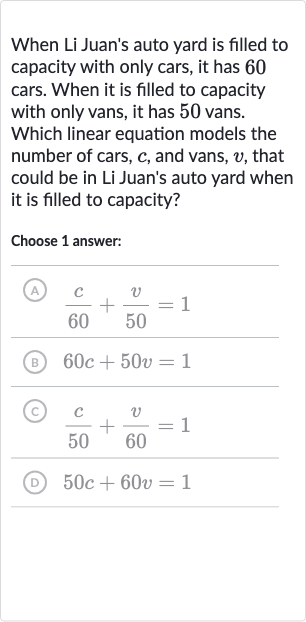AI tutor
Welcome to Bytelearn!
Let’s check out your problem:

When Li Juan's auto yard is filled to capacity with only cars, it has cars. When it is filled to capacity with only vans, it has vans. Which linear equation models the number of cars, , and vans, , that could be in Li Juan's auto yard when it is filled to capacity?Choose answer:(A) (B) (C) (D)
Full solution
Q. When Li Juan's auto yard is filled to capacity with only cars, it has cars. When it is filled to capacity with only vans, it has vans. Which linear equation models the number of cars, , and vans, , that could be in Li Juan's auto yard when it is filled to capacity?Choose answer:(A) (B) (C) (D)
- Maximum Capacity of Auto Yard: Let's consider the maximum capacity of the auto yard in terms of space. When filled with cars, the yard holds cars, and when filled with vans, it holds vans. We can assume that each car takes up the same amount of space, and each van takes up the same amount of space. However, the space taken by a car is not necessarily the same as the space taken by a van.
- Relationship between Cars and Vans: We need to find a relationship between the number of cars and vans that can fit in the yard when it is at full capacity. Since the yard can hold cars, we can say that car takes up of the yard's capacity. Similarly, since the yard can hold vans, van takes up of the yard's capacity.
- Fraction of Yard's Capacity: If we have cars in the yard, they would take up of the yard's capacity. Similarly, if we have vans in the yard, they would take up of the yard's capacity. The sum of these two fractions should equal , because together they fill the yard to capacity.
- Equation for Capacity Relationship: The equation that represents this relationship is . This equation states that the fraction of the yard's capacity taken up by cars plus the fraction taken up by vans equals the entire capacity of the yard.
- Matching Answer Choice: Looking at the answer choices, we can see that option (A) matches our derived equation: .
